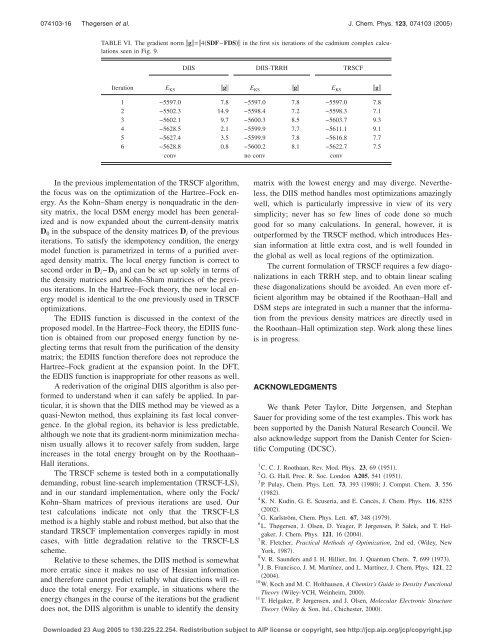Get my PhD Thesis
Get my PhD Thesis
Get my PhD Thesis
You also want an ePaper? Increase the reach of your titles
YUMPU automatically turns print PDFs into web optimized ePapers that Google loves.
074103-16 Thøgersen et al. J. Chem. Phys. 123, 074103 2005<br />
TABLE VI. The gradient norm g=4SDF−FDS in the first six iterations of the cadmium complex calculations<br />
seen in Fig. 9.<br />
DIIS DIIS-TRRH TRSCF<br />
Iteration<br />
E KS g E KS g E KS g<br />
1 −5597.0 7.8 −5597.0 7.8 −5597.0 7.8<br />
2 −5502.3 14.9 −5598.4 7.2 −5598.3 7.1<br />
3 −5602.1 9.7 −5600.3 8.5 −5603.7 9.3<br />
4 −5628.5 2.1 −5599.9 7.7 −5611.1 9.1<br />
5 −5627.4 3.5 −5599.9 7.8 −5616.8 7.7<br />
6 −5628.8 0.8 −5600.2 8.1 −5622.7 7.5<br />
conv no conv conv<br />
In the previous implementation of the TRSCF algorithm,<br />
the focus was on the optimization of the Hartree–Fock energy.<br />
As the Kohn–Sham energy is nonquadratic in the density<br />
matrix, the local DSM energy model has been generalized<br />
and is now expanded about the current-density matrix<br />
D 0 in the subspace of the density matrices D i of the previous<br />
iterations. To satisfy the idempotency condition, the energy<br />
model function is parametrized in terms of a purified averaged<br />
density matrix. The local energy function is correct to<br />
second order in D i −D 0 and can be set up solely in terms of<br />
the density matrices and Kohn–Sham matrices of the previous<br />
iterations. In the Hartree–Fock theory, the new local energy<br />
model is identical to the one previously used in TRSCF<br />
optimizations.<br />
The EDIIS function is discussed in the context of the<br />
proposed model. In the Hartree–Fock theory, the EDIIS function<br />
is obtained from our proposed energy function by neglecting<br />
terms that result from the purification of the density<br />
matrix; the EDIIS function therefore does not reproduce the<br />
Hartree–Fock gradient at the expansion point. In the DFT,<br />
the EDIIS function is inappropriate for other reasons as well.<br />
A rederivation of the original DIIS algorithm is also performed<br />
to understand when it can safely be applied. In particular,<br />
it is shown that the DIIS method may be viewed as a<br />
quasi-Newton method, thus explaining its fast local convergence.<br />
In the global region, its behavior is less predictable,<br />
although we note that its gradient-norm minimization mechanism<br />
usually allows it to recover safely from sudden, large<br />
increases in the total energy brought on by the Roothaan–<br />
Hall iterations.<br />
The TRSCF scheme is tested both in a computationally<br />
demanding, robust line-search implementation TRSCF-LS,<br />
and in our standard implementation, where only the Fock/<br />
Kohn–Sham matrices of previous iterations are used. Our<br />
test calculations indicate not only that the TRSCF-LS<br />
method is a highly stable and robust method, but also that the<br />
standard TRSCF implementation converges rapidly in most<br />
cases, with little degradation relative to the TRSCF-LS<br />
scheme.<br />
Relative to these schemes, the DIIS method is somewhat<br />
more erratic since it makes no use of Hessian information<br />
and therefore cannot predict reliably what directions will reduce<br />
the total energy. For example, in situations where the<br />
energy changes in the course of the iterations but the gradient<br />
does not, the DIIS algorithm is unable to identify the density<br />
matrix with the lowest energy and may diverge. Nevertheless,<br />
the DIIS method handles most optimizations amazingly<br />
well, which is particularly impressive in view of its very<br />
simplicity; never has so few lines of code done so much<br />
good for so many calculations. In general, however, it is<br />
outperformed by the TRSCF method, which introduces Hessian<br />
information at little extra cost, and is well founded in<br />
the global as well as local regions of the optimization.<br />
The current formulation of TRSCF requires a few diagonalizations<br />
in each TRRH step, and to obtain linear scaling<br />
these diagonalizations should be avoided. An even more efficient<br />
algorithm may be obtained if the Roothaan–Hall and<br />
DSM steps are integrated in such a manner that the information<br />
from the previous density matrices are directly used in<br />
the Roothaan–Hall optimization step. Work along these lines<br />
is in progress.<br />
ACKNOWLEDGMENTS<br />
We thank Peter Taylor, Ditte Jørgensen, and Stephan<br />
Sauer for providing some of the test examples. This work has<br />
been supported by the Danish Natural Research Council. We<br />
also acknowledge support from the Danish Center for Scientific<br />
Computing DCSC.<br />
1 C. C. J. Roothaan, Rev. Mod. Phys. 23, 691951.<br />
2 G. G. Hall, Proc. R. Soc. London A205, 541 1951.<br />
3 P. Pulay, Chem. Phys. Lett. 73, 393 1980; J. Comput. Chem. 3, 556<br />
1982.<br />
4 K. N. Kudin, G. E. Scuseria, and E. Cancès, J. Chem. Phys. 116, 8255<br />
2002.<br />
5 G. Karlström, Chem. Phys. Lett. 67, 348 1979.<br />
6 L. Thøgersen, J. Olsen, D. Yeager, P. Jørgensen, P. Sałek, and T. Helgaker,<br />
J. Chem. Phys. 121, 162004.<br />
7 R. Fletcher, Practical Methods of Optimization, 2nd ed. Wiley, New<br />
York, 1987.<br />
8 V. R. Saunders and I. H. Hillier, Int. J. Quantum Chem. 7, 6991973.<br />
9 J. B. Francisco, J. M. Martínez, and L. Martínez, J. Chem. Phys. 121, 22<br />
2004.<br />
10 W. Koch and M. C. Holthausen, A Chemist’s Guide to Density Functional<br />
Theory Wiley-VCH, Weinheim, 2000.<br />
11 T. Helgaker, P. Jørgensen, and J. Olsen, Molecular Electronic Structure<br />
Theory Wiley & Son, ltd., Chichester, 2000.<br />
Downloaded 23 Aug 2005 to 130.225.22.254. Redistribution subject to AIP license or copyright, see http://jcp.aip.org/jcp/copyright.jsp

















